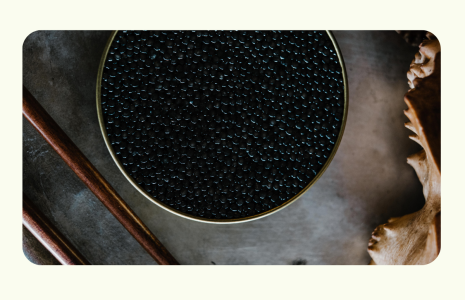
Oscietra To Beluga – What The Price Of Caviar Tells You
In French cuisine, it is well known that caviar is the epitome of luxury, the summit of sumptuousness, and the apex of opulence – it has always fascinated casual enthusiasts and connoisseurs alike.
But let’s be completely honest with each other, it can cost a pretty penny or two.
The price tag of Caviar is a window into its origin and quality and reflects the intricate processes around its production. Each bit of it tells a special story of species, from the water to the way it has been harvested.
In this post, we’re going to take a deep dive into what the price of Caviar tells you. Exploring everything from the humble Lumpfish to the extravagance of Beluga Caviar, we’ll explore how price becomes a compass through the nuances of taste.
What The Price Of Caviar Tells You
Types of Caviar
Beluga
Texture: Beluga caviar is known for its large, delicate, and glossy eggs. The texture is exceptionally smooth and tender, almost melting in your mouth.
Taste: It is celebrated for its mild and buttery flavour. The taste is often described as rich, creamy, and slightly nutty, making it one of the most sought-after and luxurious caviars in the world.
Appearance: The eggs are typically the largest among caviar varieties, ranging from light grey to deep black. They have a glossy sheen and a smooth, unblemished surface.
You can get a taste of Beluga caviar for yourself with our collection of Caspian Royal Beluga Caviar here.
Oscietra
Texture: Oscietra caviar is usually medium to large-sized eggs with a distinct texture. They are firm yet burst with a satisfying pop when gently pressed between the tongue and palate.
Taste: This caviar is prized for its complex and robust flavour profile. It often exhibits a nutty and buttery taste, making it a delicacy favoured by caviar connoisseurs. The flavour can vary depending on the processing method, but it generally offers a well-balanced and satisfying taste.
Appearance: Oscietra caviar ranges in colour from dark brown to golden or amber hues. The eggs have a shiny, almost translucent quality, and their appearance exudes luxury.
You try Oscietra caviar for yourself with our collection of Caspian Oscietra Caviar here.
Lumpfish
Texture: Lumpfish caviar stands in stark contrast to the previous two varieties. It features small, firm, and robust eggs that have a more pronounced resistance when bitten into.
Taste: While not as delicate or complex as Beluga or Oscietra, lumpfish caviar offers a pronounced salty flavour. It is often used as a more affordable alternative to pricier caviars.
Appearance: The eggs are small, typically ranging in colour from vibrant red to black. The appearance is distinctive due to its bright and colourful hues, making lumpfish caviar visually appealing for garnishing dishes.
Factors Influencing Price
Fish species
Different fish species produce caviar of varying quality and flavour. The most prized caviar typically comes from sturgeon species, such as Beluga and Oscietra. These sturgeon species produce larger, more delicate eggs with complex flavours, which are highly sought after by connoisseurs.
Other fish species, like salmon or trout, produce caviar that is generally less expensive and considered less prestigious. The size and texture of their eggs differ from sturgeon caviar, leading to a lower market value.
Rarity
Rarity plays a significant role in determining the price of caviar. Some sturgeon species, like Beluga, are critically endangered, and their caviar is incredibly rare. Due to conservation efforts and international regulations, the harvesting of caviar from these endangered species is heavily restricted, driving up its price.
However, Caviar from more abundant sturgeon species or sustainable sources tends to be more accessible and affordable due to its relative abundance.
Harvesting
The method used to harvest caviar can impact its price. Traditional methods that involve hand-extraction of caviar from live sturgeon often yield higher-quality caviar but are labour intensive and time consuming, leading to pricier caviar.
In contrast, some sturgeon are raised in controlled environments. This can result in more consistent and readily available caviar, which is generally less expensive.
Sustainable and environmentally responsible harvesting methods may also increase the cost as they often require careful monitoring and compliance with regulations, adding to production expenses.
How The Challenges Of Producing Caviar Impact The Price
Demand and Supply
The supply of high-quality caviar is primarily sourced from sturgeon species, many of which are endangered or subject to stringent harvesting regulations. This limited supply can result in scarcity, driving up prices and creating a delicate balance between the demand for caviar and its availability.
Sustainable Fishing
Sturgeon species have extended maturation periods before they can produce caviar, making it difficult to rebuild populations and achieve sustainable harvests.
This extended timeframe poses financial challenges for caviar producers aiming to shift toward sustainable practices.
Balancing the demand for caviar, the protection of sturgeon populations, and fostering sustainability requires concerted efforts among everyone involved in the process, and therefore the price of caviar is often a reflection of the labour and processes put in place to ensure ethically and sustainably sourced caviar.
Enjoy!
Whether it’s the time it takes to produce caviar or the hoops the suppliers have to jump through to make sure the caviar they supply is up to industry standards, there are a lot of factors which affect the price of caviar. So the next time you purchase a tin of caviar, you’ll be able to have a bit more peace of mind knowing that your money is being spent on something which warrants the price tag.
You can explore our whole range of caviar here from Caspian Caviar, including beluga, oscietra and their house selection.
Finally, our blog post on How To Store And Serve Caviar is another useful tool for making sure you are getting the most out of your caviar.


